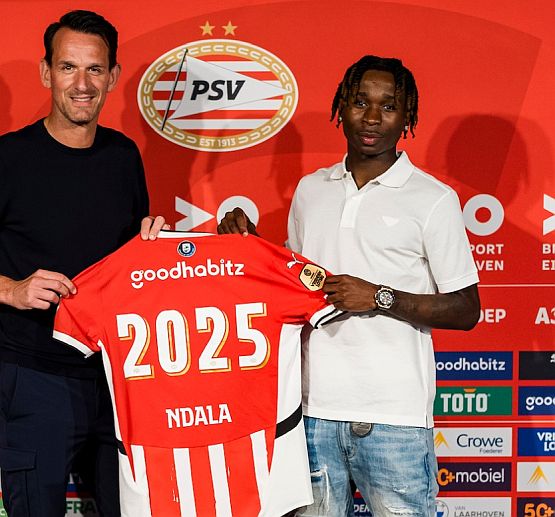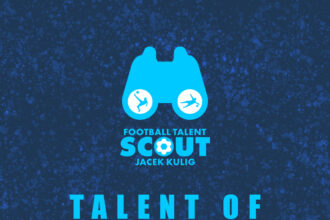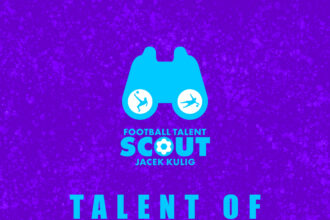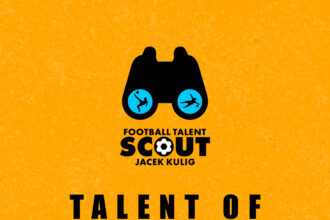Joel Ndala – England’s Emerging Gamebreaker by MaxTalksFootball

Name: Joel Ndala
Age: 18
Position: LW/RW
Foot: Right
Team: Manchester City (PSV – loan)
Nationality: England/DR Congo
Height: 178 cm
Similar Player – Jeremy Doku
Profile overview:
Joel Ndala’s game is defined by his ball carrying. Shown in his strengths of acceleration, balance, agility and excellent spatial awareness with control over his body relative to the ball, culminating in top dribbling ability. Being able to receive the ball in motion and turn quickly under pressure makes him difficult to defend, especially as he manipulates his body well in contact situations, showing strong balance and core stability despite a slim frame. This coupled with a sense of when to accelerate and decelerate sees him glide past challenges often. He has a decent understanding of when to come short for the ball and when to attempt to make runs in behind with decent variation in his movement. His pressing intensity, and general tenacity in his game is impressive and somewhat unique in the style of player he is. His confident, fearless approach to taking on defenders highlights his potential as a gamebreaking style of player.
Best position:

Strengths
- Impressive acceleration and change of pace
- Effective body manipulation in contact situations
- Ability to come inside
- Receiving the ball on the turn and in motion
- Receiving the ball at varying angles
- Strong pressing intensity in certain phases
- Ability to glide through challenges
Concerns
- Inconsistent decision-making, particularly in the final third
- Lack of decisiveness and understanding of tempo
- Poor weak foot and ability to generate power
- Predictable ball movement when isolated on the wing
- Struggles to create deception when shifting between inside and outside
- Poor final ball and weight of passing
- Weak defensive awareness
Written introduction:
Joel Ndala joined Manchester City from Port Vale in 2017 at the age of 10, and even then, his talent was unmistakable. Former coach Callum Rollings recalls just how special Ndala was, noting that he often played two age groups above his own because his peers weren’t challenging enough (via The Guardian). Inevitably, Ndala continued to rise through the ranks of City’s academy, earning his first professional contract in July 2022.
Already being earmarked as one of the academy’s brightest prospects his stock rose further following an impressive showing at the U17 World Cup, where he played as England’s first-choice left-winger. Despite a disappointing tournament for the Young Lions, Ndala stood out, contributing two assists and scoring in three consecutive games. Unanimously considered England’s standout performer, the stage felt set and it seemed only a matter of time before he broke into City’s first team.
However, in the summer of 2024, the club made a surprising move by agreeing to send Ndala on loan to PSV Eindhoven, with an option to make the transfer permanent. Despite all the promise, Ndala left City without ever making his senior debut, but this shouldn’t be too much of a cause for concern, Romeo Lavia and Morgan Roger have followed similar paths. So this deviation should by no means be seen as an indictment on his talent and the fact that City inserted a 20% sell-on clause in the deal suggests the club still believes in Ndala’s potential, even if his journey won’t unfold at the Etihad. Ndala’s move to the Eredivisie, a league that has been a proven platform for young English talent, represents a new chapter. Players like Mason Mount, Jarrad Branthwaite, and Noni Madueke have all benefited from time spent in the Netherlands, and Ndala will hope to follow in their footsteps. PSV U21 Technical Manager Jan Vennegoor has already expressed his excitement about Ndala’s arrival, echoing the sentiment held around his talent and praising his speed and technique, which he believes are ideally suited to Dutch football (via psv.nl).
Now with the chance to play regular senior football in a competitive league, Ndala has an opportunity to prove why he was once regarded as one of Manchester City’s most exciting prospects. The question that remains is just how good can Joel Ndala be?
Analysis – Full breakdown
Technical Attributes
Dribbling:
His dribbling style is fairly unique, but reminiscent of players like Grealish and Hazard in his low centre of gravity, body manipulation and ability to ride challenges as well as in the inviting of pressure, this seems to make him particularly effective when gliding horizontally inside. However, he can sometimes struggle in 1v1 situations from a standstill, especially when isolated on the touchline, where his dribbling becomes more predictable but also is often doubled up on. In my opinion he can fail to angle his hips deceptively or shift the ball quickly enough to beat defenders when moving outside sometimes, possibly symptomatic of a reluctance to use his weak foot, a significant improvement in this would likely improve his overall game.
Example of: driving up the pitch and effectiveness in coming inside
Example of: loses the ball in 1v1 after slowing down.
Ball Control:
Ndala’s close control is generally strong, especially in motion. His reactions and body positioning allow him to recover the ball well in dynamic situations, and his balance and low centre of gravity contribute to his ability to shield the ball and frame, as well as evade challenges in tight spaces. He demonstrates good awareness when receiving the ball and his first touch is generally good to allow him to turn under pressure. However his actual ball manipulation is okay but can be clunky at times.
Final Ball:
The extent of Ndalas’ creativity and vision is fleeting in its consistency in delivering the final pass or shot. His decision-making in the final third often lacks sharpness, with poor execution of passes and weak ball striking. While he can create separation for shooting opportunities, his weak foot and overall shooting power need improvement. His passing, particularly under pressure or in tight spaces, frequently lacks the necessary weight and precision, and the expansiveness and creativity of his pass types should also improve. Often does not create proper angles that allow him the best chance to execute final balls.
Physical Attributes
Pace & Acceleration:
One of Ndala’s standout traits is his acceleration and ability to change pace. In close quarters, his agility and quick bursts of speed help him evade markers. He’s generally good at covering ground in open spaces but I wouldn’t say he possesses blistering pace.
Agility & Core Strength:
Ndala’s agility in conjunction with a strong core and spatial awareness are his major assets. His ability to shift his body and manipulate contact with defenders allows him to turn efficiently and maintain control under pressure. His core stability helps him hold his ground in physical duels, although his slim build can sometimes limit his effectiveness when holding up the ball. Despite tending to invite pressure to turn players, he seems to lack an understanding of when he should look to draw fouls.
Example of: Low centre of gravity and core strength, using body to turn opposing player effectively
Tactical Awareness
Positioning:
His ability to glide into central spaces, ride challenges, and pick up pockets of space makes him more dangerous when operating inside. His effectiveness seems to dip when he is kept wide and tasked with taking on full-backs in traditional 1v1.
Defensive Contribution:
While Ndala’s pressing is really good, he seems to lack awareness in his positioning, particularly in transitions.

Example of: Good willingness to press
Mental Attributes
Decision-Making:
Ndala’s decision-making is one of the key areas for improvement. He can lack decisiveness, dwelling on the ball too long and missing opportunities to release passes or take shots at the right moments, particularly when the tempo of the game demands quicker decisions, which impacts his overall influence. He sometimes invites unnecessary pressure by holding onto the ball too long in dangerous areas of the pitch and as said before, in situations where he should use his body to draw fouls, he sometimes lacks the awareness to execute effectively.

Example of: Holding onto the ball too long, particularly in a dangerous area, situation where he should probably look for a foul as his best option.
Bravery & Confidence:
Ndala plays with a fearless attitude, frequently looking to take on defenders. His confidence in his ability to beat his marker and his directness make him a constant offensive threat.
Statistical Backing (sourced from – Sofascore)
U17 Club World Cup:
- Dribbles Completed: During the U17 World Cup Ndala completed the most dribbles in the entire tournament with 27 – 6 more than the player with the second most, despite going out in the quarter finals.
- Key Passes/Final Ball: Despite all these dribbles in the same tournament he created just 1 big chance.
Last 3 game analysis (minimum 45 minutes):
| Stat Category | Game 1 | Game 2 | Game 3 | Total/Avg |
| Minutes Played | 45 | 45 | 90 | 180 |
| Touches | 34 | 30 | 58 | 122 (Average: 40.67) |
| Accurate Passes | 16/21 (76%) | 14/17 (82%) | 30/33 (91%) | 60/71 (84.5%) |
| Key Passes | 1 | 0 | 0 | 1 |
| Shots on target | 1 | 1 | 0 | 2 |
| Shots off target | 0 | 0 | 0 | 0 |
| Dribble Attempts (Succ.) | 2 (2) | 5 (2) | 9 (3) | 16 (7) |
| Ground Duels (Won) | 7 (4) | 10 (5) | 16 (7) | 33 (16) |
| Total Tackles | 2 | 1 | 2 | 5 |
| Interceptions | 1 | 0 | 0 | 1 |
| Possession Lost | 12 | 8 | 16 | 36 |
| Fouls Committed | 0 | 1 | 0 | 1 |
| Fouled | 0 | 2 | 2 | 4 |
| Big Chances Missed | 0 | 0 | 1 | 1 |
| Offsides | 0 | 1 | 1 | 2 |
| Crosses (Accurate) | 0 | 0 | 1(0) | 1(0) |
1. Dribbling: Across the three games, Ndala attempted 16 dribbles, completing 7 successfully (about 44% success rate). The number of dribble attempts reflects his dribble-focused profile and confidence in taking on defenders, showing his desire to carry the ball forward and the fact that he continues to attempt dribbles, even when unsuccessful, backs up the claim that he is relentless in this aspect.
However, the lower success rate (especially in Game 3 with 9 attempts but only 3 successful) may back the claim that, while he is capable of impressive ball carrying, he struggles against tight defences or in 1v1 situations, which aligns with the criticism of his predictability in wide areas.
2. Ground Duels: Ndala won 16 out of 33 ground duels across the three games, showing that he is highly involved in physical contests. His strong balance and ability to use his core strength is supported by his consistent engagement in ground duels. He does have the ability to win a significant number of duels supporting the assessment of his balance, body control, and core stability. Especially in the best sample size of 90 minutes in Game 3, he won 7 of 16 duels, also reflecting his tenacity in physical encounters.
However, the overall lower win rate in these duels (less than 50%), is still reflecting his slim frame might limit his ability to consistently win these battles, aligning with the assessment that while his core strength is good, it is not sufficient to dominate more physical defenders.
3. Total Tackles: Across the three games, Ndala made 5 tackles (2 in Game 1 and Game 3), showing decent defensive involvement in pressing and ball recovery. The tackles reflect his tenacity and willingness to contribute defensively,
The low number of interceptions (1 interception across all games) could suggest lapses in defensive positioning and awareness.
4. Shots on Target: Ndala had 2 shots on target across the three games (1 in Game 1 and 1 in Game 3).He has the ability to create shooting positions, through good separation and seems to have a sensible understanding of when to go for shots, with good shot locations being inside the box and all shots being on target. There is still reflection of poor output and quality having relatively low shot output across the minutes, no goals and missing a big chance in Game 3.
5. Key Passes: Ndala had only 1 key pass (in Game 1). This aligns with the assessment that his final ball execution and creativity are inconsistent. Although his passing accuracy improved across the games, culminating in 91% accuracy in Game 3, the absence of key contributions in attack (key passes, assists) could reflect a lack of impactful decision-making in the final third. The high pass accuracy itself could also be indicative of safe non-expansive/creative passing.
6. Possession Lost: Ndala lost possession 36 times over the three games, with the highest number (16) in Game 3. This high number of possession losses backs the claim that he can hold onto the ball too long, leading to turnovers. This stat supports the criticism of decision-making and suggests that he could improve his ability to release at the right times or, also backing up my claim, get better at enticing fouls as an alternative for turn-over when losing duels.
7. Dribble Success Rate: With 7 successful dribbles out of 16 attempts, the overall dribble success rate of 44% indicates that Ndala can possibly become predictable, especially in 1v1 situations where better defenders learn how to neutralise him. The drop in dribble success (from 100% in Game 1 to 33% in Game 3) as his dribble attempts increase, supports this idea.
Summary
How good can Joel Ndala be?
As hinted toward in the title of this report the style of Joel Ndala will always be a valuable one as a game breaking style player that can take the game to opponents and is capable of moments of magic in an instance but yet he is a very raw player. There are some clear deficiencies to his game preventing me from fully tipping him to be amongst the best. An exciting player nonetheless, the type where you watch a game just to see him. For that reason I would recommend checking in on Joel Ndalas development regardless.
Potential rating: 8.5/10






